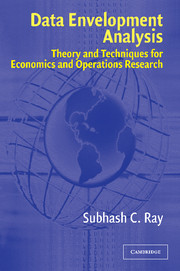Book contents
- Frontmatter
- Contents
- Preface
- 1 Introduction and Overview
- 2 Productivity Efficiency, and Data Envelopment Analysis
- 3 Variable Returns to Scale: Separating Technical and Scale Efficiencies
- 4 Extensions to the Basic DEA Models
- 5 Nonradial Models and Pareto–Koopmans Measures of Technical Efficiency
- 6 Efficiency Measurement without Convexity Assumption: Free Disposal Hull Analysis
- 7 Dealing with Slacks: Assurance Region/Cone Ratio Analysis, Weak Disposability, and Congestion
- 8 Efficiency of Merger and Breakup of Firms
- 9 Efficiency Analysis with Market Prices
- 10 Nonparametric Approaches in Production Economics
- 11 Measuring Total Productivity Change over Time
- 12 Stochastic Approaches to Data Envelopment Analysis
- 13 Looking Ahead
- References
- Index
9 - Efficiency Analysis with Market Prices
Published online by Cambridge University Press: 24 November 2009
- Frontmatter
- Contents
- Preface
- 1 Introduction and Overview
- 2 Productivity Efficiency, and Data Envelopment Analysis
- 3 Variable Returns to Scale: Separating Technical and Scale Efficiencies
- 4 Extensions to the Basic DEA Models
- 5 Nonradial Models and Pareto–Koopmans Measures of Technical Efficiency
- 6 Efficiency Measurement without Convexity Assumption: Free Disposal Hull Analysis
- 7 Dealing with Slacks: Assurance Region/Cone Ratio Analysis, Weak Disposability, and Congestion
- 8 Efficiency of Merger and Breakup of Firms
- 9 Efficiency Analysis with Market Prices
- 10 Nonparametric Approaches in Production Economics
- 11 Measuring Total Productivity Change over Time
- 12 Stochastic Approaches to Data Envelopment Analysis
- 13 Looking Ahead
- References
- Index
Summary
Introduction
In DEA models for measuring input-oriented technical efficiency, the objective was to contract all inputs at the same rate to the extent possible without reducing any output. In practice, however, some inputs are more valuable than other inputs and conserving such inputs would be more efficient than saving other inputs. When market prices of inputs are available, the firm would seek to minimize the total input cost for a given level of output. This would mean not only that inputs are changed by different proportions but also that some inputs may actually be increased while others are reduced when that is necessary for cost minimization. Our discussion of DEA, so far, has made no use whatsoever of prices of inputs and or outputs. Even in our discussion of nonradial measures of efficiency, although disproportionate changes in inputs and outputs were allowed, we did not consider the possibility that some inputs could actually be increased or that some outputs could be reduced. This is principally due to the fact that DEA was originally developed for use in a nonmarket environment where prices are either not available at all or are not reliable, even if they are available. This may give the impression that when accurate price data do exist, it would be more appropriate to measure efficiency using econometric methods with explicitly specified cost or profit functions and not to use DEA. This, however, is not the case.
Information
- Type
- Chapter
- Information
- Data Envelopment AnalysisTheory and Techniques for Economics and Operations Research, pp. 208 - 244Publisher: Cambridge University PressPrint publication year: 2004
